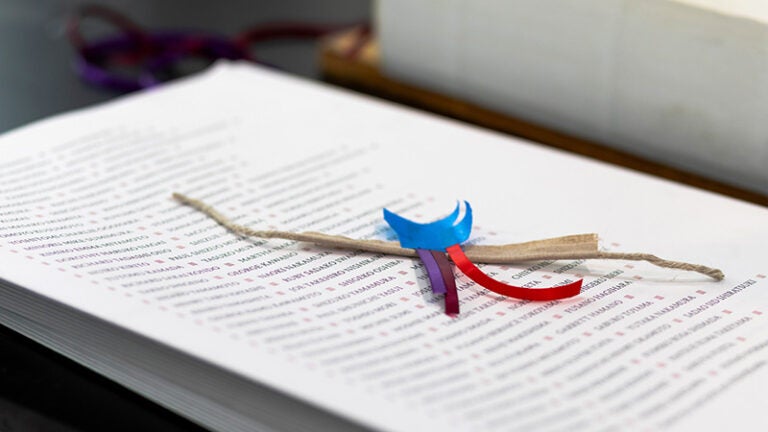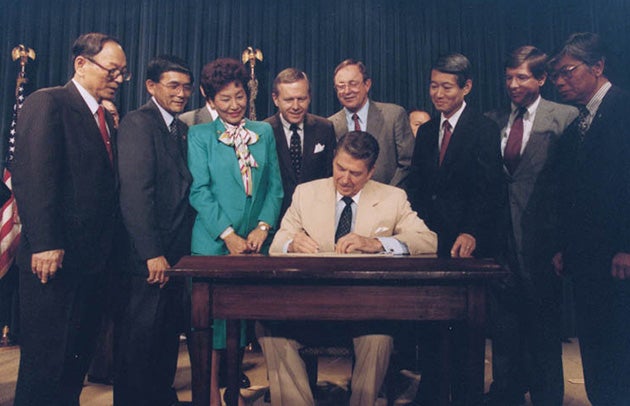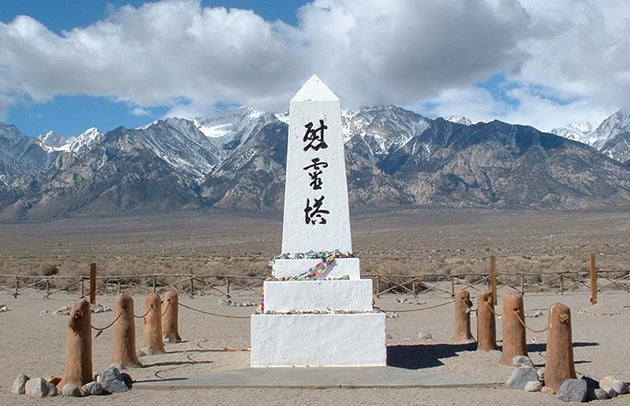
Japanese Americans were forcibly imprisoned in camps during World War II. We finally know all their names
In brief:
The names of thousands of Japanese Americans sent to prison camps during World War II were lost or misspelled in the decades following the war.
USC Dornsife scholar Duncan Williams recently finished the first complete and accurate accounting of all those who were imprisoned.
The list in book form is on display at the Japanese American National Museum in Los Angeles.
Starting in 2024, a series of structures displaying these names will be installed at former prison camp sites.
On Sept. 12, a group of Buddhist, Christian and Shinto clergy walked solemnly through downtown Los Angeles toward the Japanese American National Museum (JANM), carrying a book. Printed on its pages were the names of 125,284 Japanese Americans forcibly imprisoned in camps during World War II. It’s the first comprehensive list of all those who were incarcerated.

In 1942, President Franklin D. Roosevelt and his administration, fearful that those of Japanese descent would remain loyal to their ancestral home over the United States during the war, issued Executive Order 9066. The order sent Japanese Americans from their homes to remote camps throughout the U.S. Some 1,600 prisoners died during their incarceration and many lost property and businesses that they were forced to abandon.
In 1988, an official apology and reparations were issued to victims under former President Ronald Reagan, but a truly complete list of all those who had been imprisoned remained elusive. Names were missing or misspelled, and the lists often didn’t include those born in the camps or who died on the way. This meant that the total number of those who had been placed in the camps was still unknown.
This first comprehensive accounting of those imprisoned is now complete thanks to the work of Duncan Williams, professor of religion, American studies and ethnicity and East Asian languages and culture and director of the USC Shinso Ito Center for Japanese Religions and Culture at the USC Dornsife College of Letters, Arts and Sciences.
It’s part of Williams and the center’s ongoing effort to memorialize the victims of this policy, a project dubbed Irei: National Monument for the WWII Japanese American Incarceration, which will include an online website and a series of monuments at former camp sites.
The Book of Names

The Reagan administration’s Civil Liberties Act of 1988 issued an apology to those interned as well as a check for $20,000 to roughly 80,000 victims. Yet, even this did not produce an accurate accounting of everyone who had been imprisoned. “I’ve interviewed staffers in that office and they said, ‘Well, you know, back then we didn’t have Excel,’” says Williams.
He has spent several years collecting names from camp rosters and other primary source documents, writing a list that not only accurately spelled each name, but which also produced the total number of people who were sentenced to the camps.
“Up until this point, everybody’s been guessing. Maybe it was 110,000 people, maybe 120,000,” says Williams. “We came to around 125,000 when we finished the project.”
The names were printed in a book dubbed IreichÃ…Â, or “The Book of Names,” a choice inspired by the Japanese tradition of KakochÃ…Â, or “The Book of the Past.” A kakocho lists those who have passed away and is placed on altars and brought out during memorial services for the names to be read.
IreichÃ…Â will remain at the JANM for a year. Relatives of victims can stop by to place a Japanese hanko, or seal, by their family member’s name, as a way to acknowledge their memory. They can also request changes or additions to the list. Once any edits have been entered at the end of its residency, the list will be considered complete.
Names in lights
The center was recently awarded a $3.4 million grant from the Mellon Foundation for their memorial project, as part of the foundation’s effort supporting work that reconsiders the future of memorials.
The next stage of the Irei project will be an online archive, accessible to the public. The interactive and searchable database of names will add personal information about each individual. This will provide both sentimental value for family members of victims and powerful genealogical and historical data to researchers.
Starting in 2024, Williams and the center will begin installing light sculptures at eight former camps, including at Manzanar in California’s Owens Valley, where many of the Japanese Americans forced from their communities in Southern California were imprisoned.
A monument will also be part of a traveling exhibit and one will become a permanent exhibit at JANM.
“We traditionally think of a monument as an installation like the Vietnam War Memorial, but this list of names is double that or more. If you tried to carve it in granite, you’d need a really large space,” explains Williams. Instead, an artistic light show will show all 125,000 names through a scrolling display.
The design of the monument is inspired by the IreitÃ…Â, or “Soul Consoling Tower,” a structure built in 1943 by imprisoned Japanese Americans at Manzanar in memory of those who had died in the camp. It still stands in the desert shrub today, soon to be joined by this new memorial to all those who once endured the camps.
